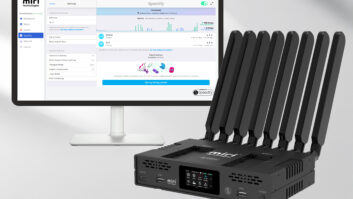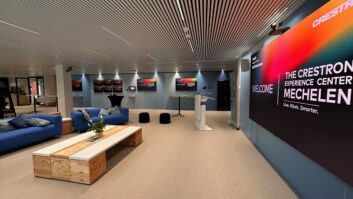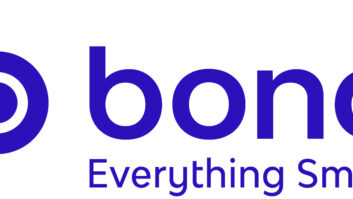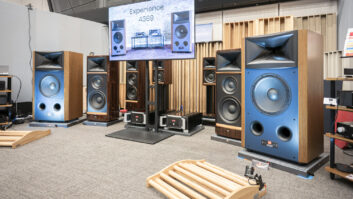NEW YORK — Last week was a busy one for RadioShack.
Within the span of two days, the nation’s No. 4 CE retailer officially launched its in-store RCA digital entertainment centers, began a 17-store test of a new store format, and hosted a private concert by performers Jewel and Lyle Lovett that is being rebroadcast exclusively in RadioShack stores.
Last Tuesday, executives from RadioShack and Thomson gathered in midtown Manhattan to formally kick off their five-year pact, which was signed in April 1999 and initiated in early January with the installation of the first RCA in-store shops.
Among those on hand for the press conference and private musical performance that followed was Thierry Breton, chairman/CEO of Thomson Multimedia. Breton said the partnership was important because it “makes it easier for consumers to learn about new technology and brings Thomson closer to one of its most important customers.”
Indeed, Michael O’Hara, Thomson’s senior VP/Americas, noted that the company’s year-to-date sales to RadioShack are already double last year’s total shipments to the chain, prompting James Meyer, Thomson’s senior executive VP and Americas chief operating officer, to observe that the deal is “an important milestone for our company.”
RadioShack chairman, president and CEO Len Roberts used the occasion to beat the drum for his 7,000 stores, which he said are visited by 1 million customers per day. That kind of market presence helped make the merchant No. 1 in wireless, selling more wireless products than all other retailers combined, he said.
Roberts also described RadioShack as a leader in DirecTV sales, noting that the 270,000 units sold during the first quarter represented a 170 percent increase over the year-ago period, and put the chain on track to meet its target of 1 million units for the year.
“We can generate $100 more per day per store,” Roberts said. “With 5,000 company-owned and 2,000 franchise RadioShack stores, you do the math.”
RadioShack executive VP/chief operating officer Dave Edmondson described the chain’s sales success as a “retail juggernaut” and attributed it to the company’s ability to “demystify [digital] technology for the mass market.”
Helping to maintain that role, he described an intensive technical training program that includes two separate certification tests to attain RCA qualification; the deployment of some 800 RCA-trained product specialists; and updates on new products and promotions delivered via RadioShack’s in-house satellite network.
The in-house satellite system, Edmondson said, is also the medium by which the Jewel/Lovett concert is being beamed into RadioShack stores this month for viewing over HDTV. He added that the retailer and RCA are also sponsoring a 13-part series of high-concept TV music specials, called “Music In High Places,” which will feature top recording artists in performance at such ancient sites at Abu Simbel, Angkor Wat and The Great Wall of China. The one-hour specials will air this fall on an as yet to be announced cable network.
Separately, RadioShack last week opened the first of 17 retrofitted stores planned for Tucson, Ariz., in a one-market test of a new format for the chain. The new design improves product adjacencies by dividing stores into four “zones” that group similar goods and services. The zones are also designed to provide visual clues that will help guide customers through the retailer’s core businesses.
The new layout clusters parts, accessories and batteries together within “the destination” zone, while A/V and computer products are grouped within “the connecting places zone.” Telecommunications products are merchandised within “the connecting people zone;” and access to RadioShack’s e-commerce site and its vast inventory can be gained through kiosks found within “the virtual zone.”
The prototype stores will be opened in three phases over the next four months and follow an experimental store format that RadioShack opened in Aurora, Colo., in March. The 20,000-square-foot concept store, dubbed RadioShack.com, is configured as a brick & mortar incarnation of the chain’s e-commerce site.
“Testing a new RadioShack store design is the next step in our business strategy,” Roberts said, “and if it proves successful, could provide RadioShack with a catalyst for a whole new level of growth.”
Roberts’ announcement of the redesign came as the company marked its first day of trading as RadioShack Corp. In a prepared statement, Roberts stressed his goal of accelerating sales and earnings by ramping up RadioShack.com, growing the company’s home-installation fleet and expanding its business-to-business model. He added that profits from recurring connectivity services, a cornerstone of his strategy, should hit $250 million by 2004.
Roberts reiterated those themes at the PaineWebber 11th Annual Growth & Technology Conference here last week, noting that the company’s retail service concept of connecting the home addresses the “do it for me market.”
The consumer experience is maximized when all elements of connectivity are optimized, he said. Thus, at the same time RadioShack is providing customers access to devices such as computers, phones, pagers, handhelds, set-top boxes and Internet appliances, it also is offering transport or service technology for narrowband, namely dial-up, and broadband, including DSL, cable, modem fixed wireless and satellite.
To that end, RadioShack will inaugurate its Microsoft Internet Store in the third quarter, offering broadband transport options such as cable modems, DSL, satellite and fixed wireless. Roberts also said an alliance between a cable company and RadioShack would be announced later this year.
“The bigger the Internet becomes, the bigger we become,” he stated. “There is great potential with the Internet for leveraging RadioShack’s unique strengths.”
Although RadioShack will remain a complete accessories store for communication, computers, audio/video and personal electronics — doing 27 percent of its business in these products — it does expect to install broadband transport options in more than 4,000 of its 7,000-plus stores in the third quarter and begin rolling out broadband sales in the fourth.
“We expect one-third of our growth to come from sign-up stuff,” said Roberts about growth in recurring connectivity revenues and its provision for chain income in the future. “There’s great opportunity for us in selling and installations.” — Additional Reporting by Jeff Malester and Steve Smith













